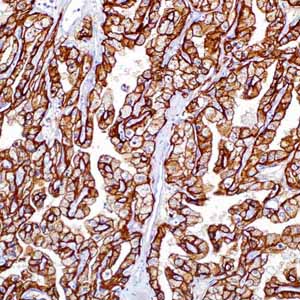
Carbonic Anhydrase IX (CA IX) (MRQ-54 (also known as M75)

CA IX are a family of zinc containing metalloproteins that catalyze the reversible hydration of CO2. Among these, CA IX is anchored to the cell membrane and is expressed in the human gastrointestinal tract, chiefly in the stomach and gall bladder1. It is interesting to note that CA IX is overexpressed in epithelial malignancies of the uterus, cervix, lung, breast, and kidney; none of the associated normal tissues express this isozyme1,2,3,4. CA IX is said to maintain the extracellular acidic pH, thus promoting cell growth in these tumors5. Preliminary data suggest consistent immunoreactivity for anti-CA IX in clear cell renal cell carcinoma (RCC); it has sensitivity of 85% to 100% for clear cell RCC and this imparts diagnostic utility. Anti-CA IX may also play a role in distinguishing clear cell RCC from chromophobe RCC. Anti-CA IX, together with antibodies against Pax 2, Ksp-cadherin, and CD117, forms a robust panel that can be used to make this distinction. Strong diffuseto-multifocal immunostaining for anti-CA IX is observed in the large majority of urothelial carcinomas as opposed to the extremely weak and focal immunoreactivity seen in collecting duct carcinoma (CDC). Anti-CA IX can thus aid in distinguishing between urothelial carcinoma and CDC6.
